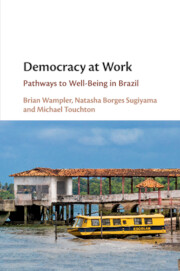Book contents
- Democracy at Work
- Democracy at Work
- Copyright page
- Contents
- Figures
- Tables
- Preface and Acknowledgments
- Interviews
- Abbreviations
- Introduction
- 1 Democracy at Work
- 2 Building Pathways for Change
- 3 Research Design, Methods, and Variables
- 4 Reducing Poverty: Broadening Access to Income
- 5 Improving Health: Saving Lives
- 6 Empowering Women: Saving Mothers and Enhancing Opportunities
- 7 Educating Society: Promoting Public Education and Learning
- 8 Pathways at Work: Lessons from Brazil’s Poor Northeast
- Conclusion
- Appendix Democracy at Work Pathways to Well-Being in Brazil
- References
- Index
2 - Building Pathways for Change
Published online by Cambridge University Press: 28 September 2019
- Democracy at Work
- Democracy at Work
- Copyright page
- Contents
- Figures
- Tables
- Preface and Acknowledgments
- Interviews
- Abbreviations
- Introduction
- 1 Democracy at Work
- 2 Building Pathways for Change
- 3 Research Design, Methods, and Variables
- 4 Reducing Poverty: Broadening Access to Income
- 5 Improving Health: Saving Lives
- 6 Empowering Women: Saving Mothers and Enhancing Opportunities
- 7 Educating Society: Promoting Public Education and Learning
- 8 Pathways at Work: Lessons from Brazil’s Poor Northeast
- Conclusion
- Appendix Democracy at Work Pathways to Well-Being in Brazil
- References
- Index
Summary
Brazil experienced significant social, political, and economic transformations during the second half of the twentieth century. The country weathered multiple political regimes, with democratic periods (1946–1964, 1985–present) interrupted by a military dictatorship (1964–1985). Rapid industrialization generated jobs, wealth, and a new national capital (Brasília), and led to massive urbanization as rural residents streamed into cities seeking employment and a better quality of life. Tens of millions of Brazilian citizens gained access to formal employment during this era, which provided the necessary public and private wealth to expand access to health care, education, and basic infrastructure. But Brazil also remained a highly unequal country throughout its impressive economic expansion. The majority of the population lacked access to essential services and resources, including decent housing, clean water, sewage, and a basic income. In this chapter, we explore how Brazil built the foundations for the democratic pathways that would prove fundamental for improving well-being in the twenty-first century.
- Type
- Chapter
- Information
- Democracy at WorkPathways to Well-Being in Brazil, pp. 58 - 84Publisher: Cambridge University PressPrint publication year: 2019



